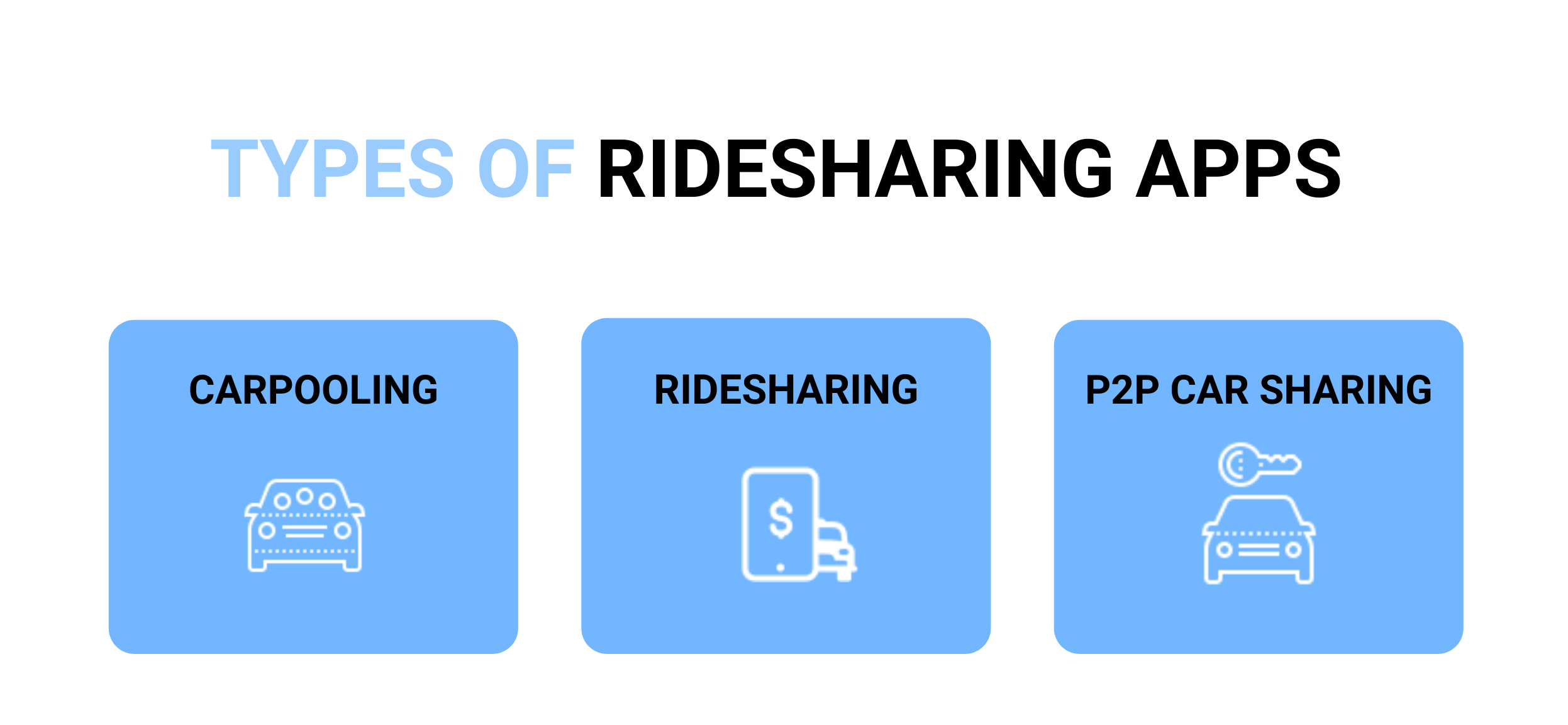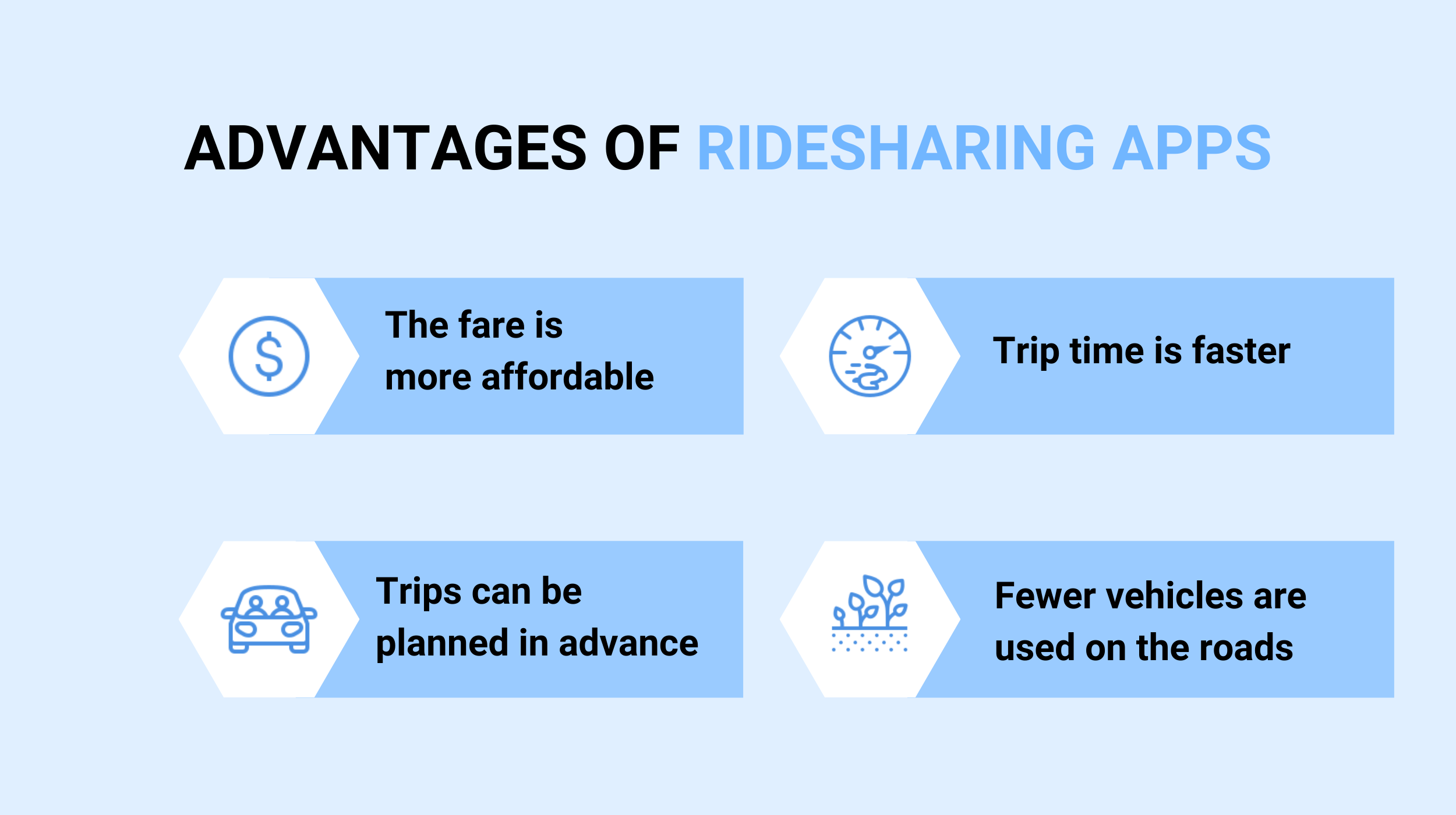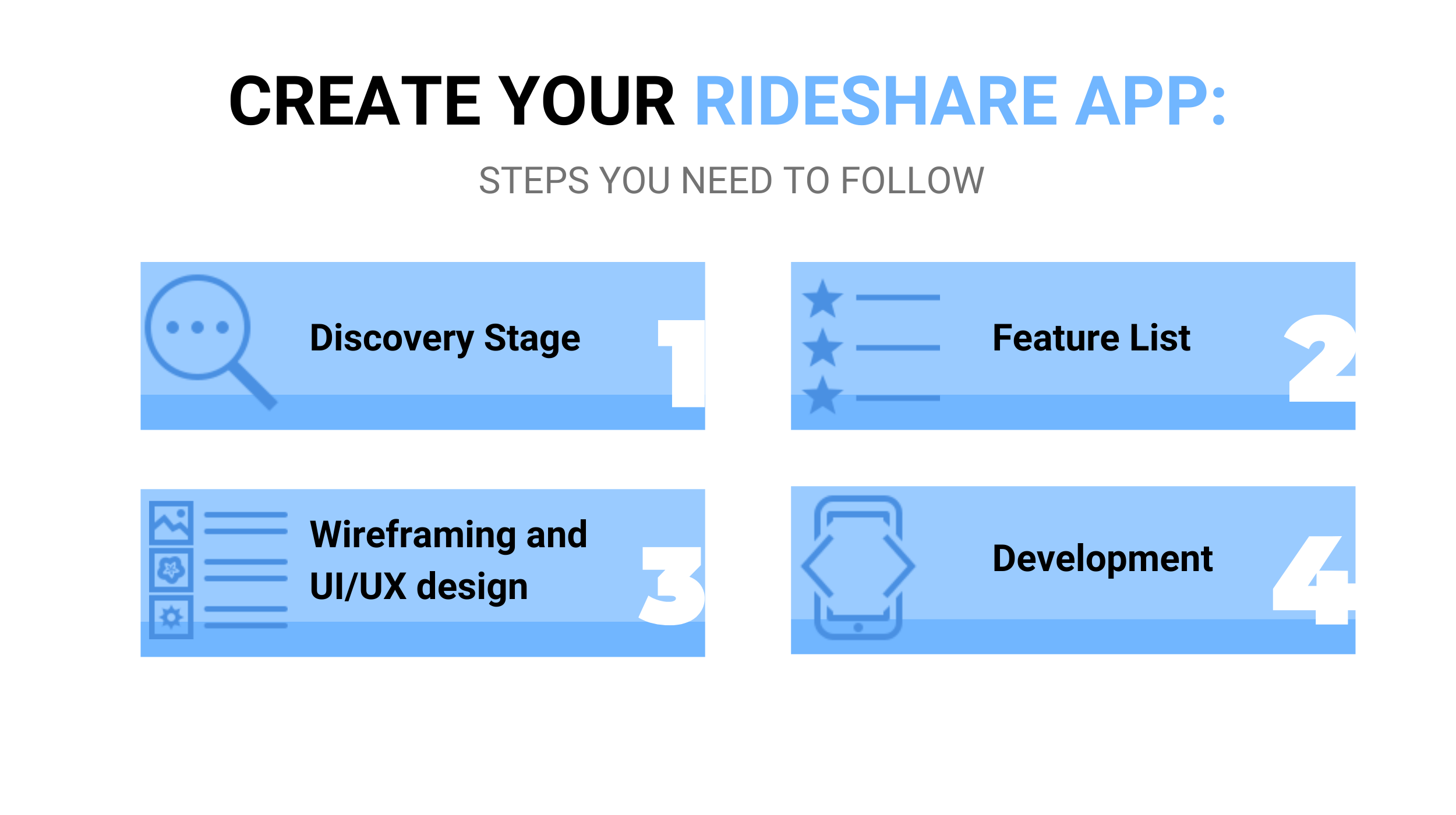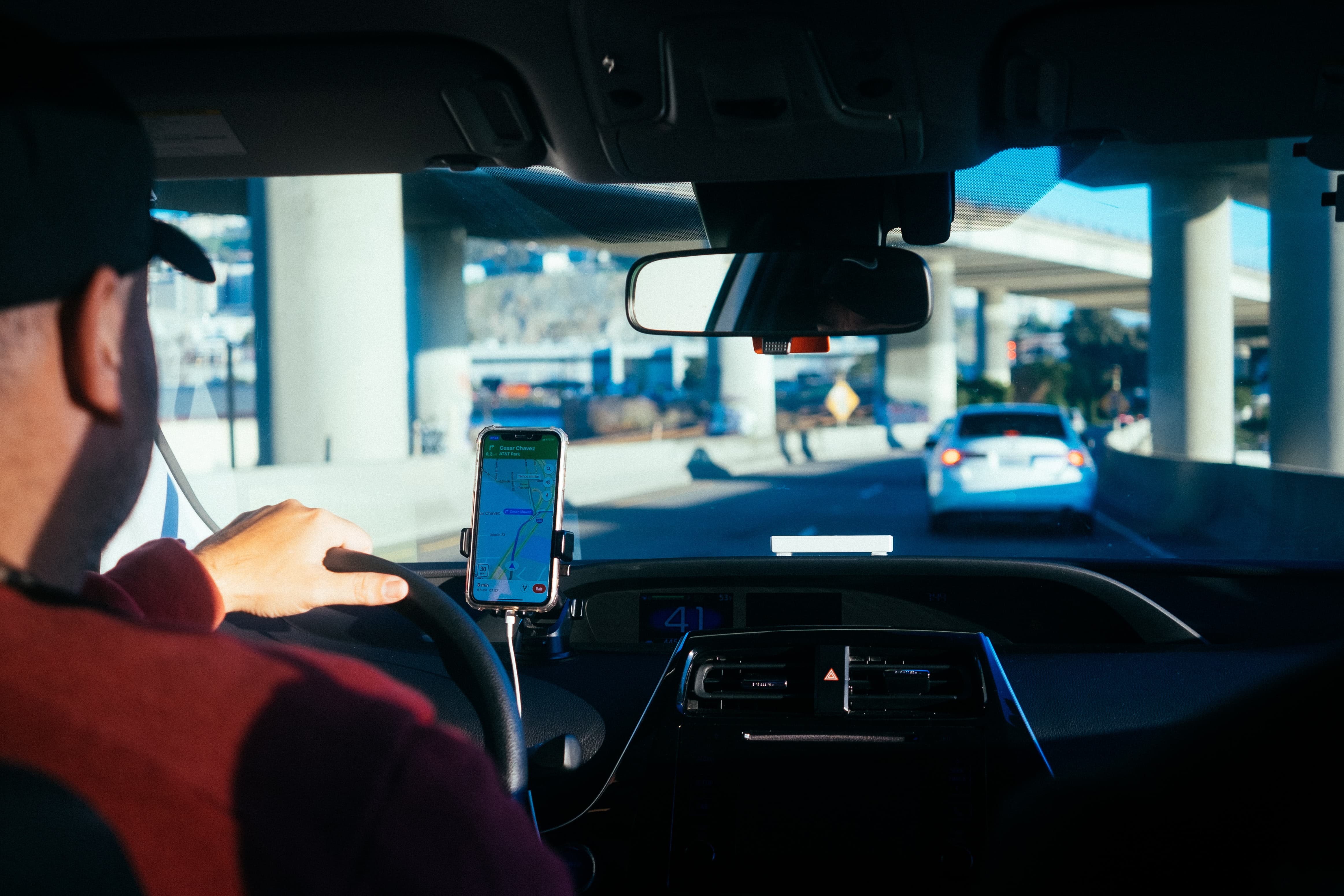Ridesharing is well-known around the world for its efficiency, affordability, and beneficial environmental influence. Famous ridesharing apps have become admitted worldwide as providers of a seamless user experience and good service.
If you desire to base a project like that, you will need to know how to make a rideshare app in detail. In the article, we answer the most recently asked questions about ridesharing. Firstly, let’s discuss the ridesharing app definition and the way this kind of app is working.
Table of Contents
- 1 What is a ridesharing app?
- 2 How does it work?
- 3 Types of ridesharing apps
- 4 Why should you consider developing a ridesharing application?
- 5 List of popular rideshare apps
- 6 Advantages and disadvantages of ridesharing apps
- 7 Let’s list the features of your future ridesharing application
- 8 How to earn money with a ridesharing app
- 9 Create your rideshare app: steps you need to follow
- 10 How to choose a tech stack for ridesharing app development
- 11 Ridesharing app development cost
- 12 What challenges may you face?
- 13 Final thoughts
What is a ridesharing app?
Ridesharing apps are differentiated from the typical taxi services. The crucial distinction is that ridesharing apps give the opportunity to find others heading to the same point. Ridesharing supposes sharing the fare. It means you can save a lot using these apps.
The concept was created by Uber in 2009. At that time company provided customers the opportunity to reserve a ride on their mobile devices. Now, Uber is the most prominent market player that has 93 million customers on the Uber platform. Moreover, 3.5 million drivers serve a growing user base.
According to research, the main driving forces of this market are the increasing congestion on the roads and the growing need for personal mobility due to the growth of urbanization and the influence of the COVID-19 pandemic. Besides, growing internet and smartphone penetration and stringent CO2 reduction targets are driving the rapid growth of the passenger sharing market.
To better realize what a ridesharing app is, let’s move on to the way they work.
How does it work?
To become a rideshare app user, every person has to register. It is worth mentioning that the are two types of user roles: driver and rider. The working mechanism is following:
- Stage #1. The rider opens the app
The rider chooses the destination, checks each travel option for vehicle size, price, and estimated return time, selects the desired option, then acknowledges receipt. - Stage #2. The rider is picked up with the driver
A driver sees and accepts the ride request. The rider is automatically notified when the car is approximately one minute away. - Stage #3. The driver picks up the rider
The driver and rider check each other’s names and destinations. Then the driver starts the ride. - Stage #4. The driver will take the rider to the destination
The app gives the driver access to a step-by-step guide. - Stage #5. Driver and rider leave ratings and reviews
At the end of each ride, drivers and riders can rate each other from 1 to 5 stars. The rider can also leave the driver tip right in the app.
Now, it’s time to discuss the types of ridesharing apps.
Types of ridesharing apps
For the beginning, are you going to start carpooling, ridesharing, or carsharing apps? Don’t confuse these terms. To make the difference clear, let’s discuss all of them in detail.

???? Carpooling
Сarpooling supposes you do not pay a commission to a third party. When cars are used together, both the passenger and the driver travel together to the destination. As usual, carpoolers are friends, colleagues, or relatives who travel daily. The driver and rider often share the cost of fuel and vehicle maintenance. Even though carpooling apps monetize their services, carpooling is usually not associated with profit.
???? Ridesharing
Ridesharing is a service that arranges one-way trips in a short time. Drivers of passing cars act like taxis. They do not travel to the same point as their driver, and at the end of the trip, the driver picks up another rider. The advantages of ridesharing are less waiting for the trip time, the opportunities to select the type of car and driver, and to rate the service provided in the app.
???? Peer-to-peer carsharing
Peer-to-peer car-sharing supposes rent the owners’ cars to others for a certain time. In P2P car sharing, the common rental car fleet is replaced by a fleet of vehicles owned by the members. With P2P car sharing, car possessors can make money when they are not using their vehicles. For their part, clients can use the nearest car and pay only for the needed time.
Why should you consider developing a ridesharing application?
The huge prevalence of ridesharing is easy to explain their comfort, accessibility, and affordability. Thousands of people living in cities travel together when they commute to work, walk or travel. Rideshare apps offer many advantages to both passengers and drivers.
Drivers save on transportation costs and profit from their vacant seats. Besides, travel sharing helps reduce traffic congestion during rush hour and reduces people’s impact on the environment. The phenomenal success of Uber and Lyft shocked the world. These ridesharing companies have disrupted common city taxi services in just a few years and become absolute leaders in their target markets.
As Statista states, in the third quarter of 2020, Uber’s adjusted net revenue globally was more than $2.8 billion, up 46% from the previous quarter when adjusted net revenue for the mobile transport company reached nearly $2 billion.
Despite strong growth in ride-sharing in recent years, it is projected to grow even faster over the next few years. A recent analysis of the market indicates that the market is expected to grow at a 20% CAGR between the end of 2019 and 2025.
Recent studies have shown that by 2021, the number of people with car-sharing apps worldwide will surpass half a billion. Market growth is projected and new travel-sharing companies will be added, as well as autonomous travel coming soon. The sharing service should skyrocket the number of daily downloads of travel sharing apps around the world.
The common taxi business was not just destroyed by taxi-ordering services like Uber, it was almost destroyed. Now people are realizing the advantages of using passenger sharing apps and are about to use them en masse. Here is the list of the best ridesharing apps.
???? Uber
The company has about 110 million customers all over the world. Its meteoric rise over the years has been recognized as a revolution in transportation. Uber’s approach has got the name “uberization” because it has proven to be an effective model when it comes to serving the needs of end-users.
???? BlaBla Car
BlaBla Car allows drivers to list their vehicles in the app, along with trips details. If any rider wants to join them, the person can request a ride and split the costs.
???? LYFT
The company offers an accessible, memorable, and welcoming user experience. Its sharing service model allows you to book a trip at a discounted price. The is a short waiting time as the driver won’t wait more than a couple of minutes as several passengers are involved.
???? Via
The moment a person orders a ride, he instantly contacts the driver travelling along the same route. The carsharing app prides itself on helping people share trips and, in turn, reduce their carbon emissions.
???? GoKid
GoKid allows parents to book a ride for their children with families they trust. This is an awesome app that helps working parents.
Advantages and disadvantages of ridesharing apps
Before you decide to create your ride-sharing app, you can take a closer look at its benefits and drawbacks for riders.

Advantages:
➕ The fare is more affordable
➕ Trip time is faster
➕ Trips can be planned in advance
➕ Fewer vehicles are used on the roads, which helps to reduce CO2 emissions.
Disadvantages:
➖ Finding rides for every location you need can be tricky
➖ Routes may differ depending on the routes other riders are expected to take.
➖ There is a risk to meet riders whose behavior you don’t like
➖ Trip times can increase depending on how many people are sharing the trip
Let’s list the features of your future ridesharing application
There are three types of users in rideshare apps. Each of them requires a specific list of features.
Features for passengers
- Check-in
Check-in allows passengers to use the app at any time. - User profiles
Profiles should include the users’ names, location, recent routes, and travel preferences. - Search filters
Search filters are essential as they help passengers find drivers heading in the right direction. Riders should also be able to filter offers by price and driver gender. - Geolocation
Geolocation should give passengers the ability to create a map of the route they choose and send it to their friends or family just in case. - Booking and cancellation
This option has to be available so that users can travel anywhere, anytime. - Chat
Chat helps both sides of the trip discuss travel details and keep in touch. - In-app payments
Regardless of whether customers need to pay for fuel and tolls or driving services, it is fast, comfortable, secure.
Features for drivers
- Registration
Registration is the first step a driver must take to get access to the car-sharing app. You can add the opportunity to register through social media or Google accounts. - User profiles
Driver profiles should consist of such data as name, phone, driving license details, location, and frequently used routes. - Maps
Maps and navigation are useful for determining the route the driver will take. - Trip posting
Trip posting is a good method for drivers to organize rides that are comfortable for them. - Chat
Chat is a critical feature that allows drivers to discuss road details with passengers. - Ratings and reviews
It’s important to build a trusting community around your market. - Notifications
Push notifications are a comfortable way to remind drivers to pick up passengers.
Features for administrators
- Vehicle Management
Administrators can inspect and verify that vehicles meet the company’s car-sharing standards. - Driver Management
This feature enables new driver validation and approval, and payment processing. - Payment Management
This allows the administrator to check driver commission rates and total earnings. - Complaint Management
This helps to calm down complaints and problems while seeking a solution. This is essential for customer retention and loyalty. - Ratings and Reviews Management
Helps the administrator track the performance of application drivers and services through ratings and customer feedback. - Revenue Report
This feature shows revenue trends and helps management get analytics monthly and improve business performance. - Dashboard
Key statistics like metrics, management, notifications, email templates are just a few things that administrators see in this feature.
Advanced features
These are optional features, but they make the sharing app more attractive and efficient for customers.
- SOS Button
This feature creates a sense of trust and safety not only for riders but also for drivers. The Safety First Rule is best implemented with this advanced solution. - New/Loyal User Discounts
Deals and discounts increase loyal customer retention as well as attract potential customers. - Plan your trip in advance
The opportunity to plan a trip makes it more convenient for users and drivers, especially when they use the app regularly. - Multilingualism
Multilingualism makes the app more convenient for a wide range of customers. It also increases the scalability of the application. - Mark favorite spots
When riders use the app and travel to places they frequent, it is convenient to be able to mark places so users don’t have to enter them every time they make a booking. Convenient booking makes your app more likely to top rankings. - Tip Drivers
Not only does this feature help the driver generate more income, but it also builds their confidence and motivation to do a good job with a sharing app. - Offline Mode
The app must continue to run when the driver enters a low-network area to avoid any problems (from locating to processing a payment).
How to earn money with a ridesharing app
If you are planning to build the rideshare app and make money from it, you should find a suitable monetization model.
There are three possible options:
- Paid ads (users see third-party ads in the app)
- Booking/Cancellation fees for passengers (riders pay a small booking fee to confirm their intentions)
- Transaction fees for car owners
BlaBlaCar makes money by charging a service fee from each rider (including VAT). I.e., if the payment is between £32 and £35, riders will pay the platform £5.
Building a mobile app isn’t just about developing it from a technical point of view. The app-building also includes several preliminary steps to ensure the success of the application.
Here are the critical steps you need to know.

Step #1. Discovery Stage
Having a unique niche is critical as it creates a new strategy for reaching leads. Do you want to create a rideshare app? So, you need to align the app with your overall business strategy. The needs of the customers, along with the expectations of your stakeholders, flow from this, hence the importance of choosing a business-sharing business model. Among other factors, you need to think about key partners, target audience, key resources, distribution channel, cost structure, and revenue stream.
Step #2. Feature List
Features make your application more efficient and more engaging to users. However, overloading an application with functions can have the opposite effect. Hence, it is important to have the optimal number of features, with particular attention to the unique features that your application can offer to end-users.
Step #3. Wireframing and UI/UX design
It is very important to have an attractive, interactive, yet simple design that will attract users of your application. The first step is wireframing, where you create a wireframe for the app screen that serves the driver app, rider app, admin panel. It can take a long time, but it sets the stage for the application’s basic functionality.
Step #4. Development
First of all, this is an internal development phase: in particular, the development team works on the application server, web server and creates a database. All the data that your sharing app works with is stored in a single database. This stage will define the functional core of the application.
Food Delivery App Development: Tips to Save Your Budget and Nerves
How to choose a tech stack for ridesharing app development
It is critical to note the tech stack, which is important during developing a rideshare app.
| Back-end | Node.js, PHP |
| Geolocation | Android – Google Maps Android API, Google Maps; iOS – CoreLocation framework, MapKit |
| Push notifications and SMS | iOS – Apple Push Notification Service, Android – Google Cloud Messaging, SMS notifications – Twilio |
| Payment integration | PayPal, Braintree, and Stripe |
| Cloud server | Amazon Web Services, Google App Engine, Microsoft Azure |
| Database | MySQL, PostgreSQL, and MongoDB |
Ridesharing app development cost
The final price of ridesharing application development always depends on the features you want to include. I.e., it takes around 9 hours to build a plain login option that combines email, phone, and password. But if you desire to add a Facebook login, it will require another 8 hours.
Besides, the final price is defined by few points:
- Selecting a platform for development (iOS, Android, or cross-platform)
- Leveraging a team composed of Project Manager, iOS Developer, Android Developer, Backend Developer, Frontend Developer, UX/UI Designer, and QA Engineer.
- Rates for hiring and working with the development team.
- Technical stack of the project.
Do not hesitate to contact us via email: andrew.gromenko@code-care.pro. We will provide you free of charge the estimation of your project.
What challenges may you face?
Starting any business involves its challenges, such as developing a product that can satisfy your target audience, competing with other market players, and raising funds for development. When developing a ridesharing application, you should also pay attention to the following points.
While ride-sharing is a great idea in terms of the benefits it brings to drivers and travelers, getting in a stranger’s car continues to be a concern for many people. To generate an influx of customers, you must convince your target audience that in-app travel bookings are safe. Here are some of the ways well-known ridesharing companies are addressing this problem.
✔ Verifying driver data is the first step to building a safe community. The world’s largest ride-sharing companies Uber and Lyft require drivers to undergo background checks and criminal charges before using their platforms.
✔ Uber uses Share My Trip to help protect its customers by allowing passengers to share ride details with people they trust. Sending real-time itinerary notifications to friends and family gives passengers peace of mind when traveling with strangers.
✔ The choice of female drivers can offer an additional guarantee of safety to women looking for travel companions through your app. To implement this option, you need to add a special filter to the search tools, as BlaBlaCar did with its Women Only feature. This feature should be available to both drivers and passengers.
✔ 24/7 online support can be very helpful for drivers. Thanks to this feature, drivers can be sure that they will receive assistance at any time in the event of an emergency.
✔ The panic button should alert the app administrator or even the police station that something is wrong during the trip.
You can use these features or come up with other ways to keep your customers safe. You can also analyze non-ridesharing companies to see how they are addressing safety issues. Perhaps you can find an idea that you can apply to your application.
Final thoughts
Access to vehicles is important nowadays, but not everybody can afford a private car. Besides, society is more conscious. Thus, ride-sharing can help reduce carbon dioxide emissions by minimizing the number of cars on the road daily.
To further help you meet client demands, you will need help building a full-featured ride-sharing app. Our team can give you detailed advice on the car-sharing app project, no matter its complexity.
















Popular
Latest